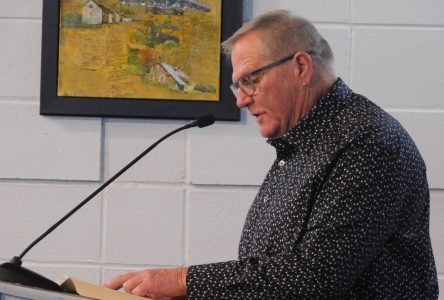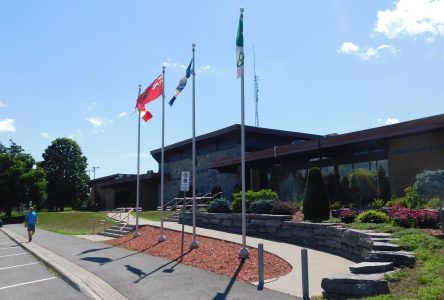Kevin Trimm bought his property 11 years ago, having moved from Montreal but didn’t start operating it as a farm until about five years ago.
It was a steep learning curve for him, even though he had some familiarity with living in a rural setting. He didn’t grow up on a farm but worked on his grandparents’ farm and at dairy operations, acknowledging that “there is a big difference” between working on a farm as a teenager and actually owning and operating a farm.
Trimm cites the regular chores of having a septic system to maintain, splitting wood to heat the house, cutting a lot of grass and having a very long driveway that needs to be cleared of snow.
“There were shocks,” he notes. “Our septic system froze the very first winter, so we had to use camping gear to manage toilet things over several months in the first year.”
Undaunted, however, Trimm and his family persevered and adjusted and the result is the Yeoman Beef Farm you see today – what might be called “regenerative agriculture,” “sustainable farming” or “permaculture.”
Drawing on a lot of research and reading – and using sustainable farming-pioneer Joel Salatin as his north star – Trimm learned the finer details of the farming he wanted to do.
Yet he doesn’t care to get too much caught up in jargon or the catch phrases and nomenclature of the farming he does: it’s more about what he calls “doing the right thing” and taking proper care of the land and the animals he’s raising on it.
Yeoman’s farming practices feature few inputs, and a lot of labour, to keep the soil whole and healthy and rich.
“The soil builds up instead of depleting. We never spray anything on our fields. We don’t even add mineral amendments or fertilizer, nor manure that isn’t our own. Our goal is to create a closed system. Our inputs are minimal.”
Getting to that point took six years of converting a conventional cash crop soy and corn farm to certified organic land.
He renovated an old barn, installed a watering system and fences, equipment buildings, planted 3,000 trees and transitioned to organic, with a caveat.
“It’s pricey and a lot of paperwork to get certified, so we just do the actual land. The more things you certify, the more complex it gets. We did use to certify the animals, but it just wasn’t worth it,” he says.
Key is the fact that the farm produces sustainable, grass-fed beef, but it’s almost a by-product of caring for the environment, good animal welfare, developing food security and engaging in the tradition and love of the “natural world,” according to Trimm.
Currently, his pricing for beef is similar to the most expensive supermarket products. But the value therein is much, much higher given the way it is farmed, he maintains.
Yeoman Beef Farm operates as a fashion of “beef club:” as a “member,” you get about 10 pounds of beef each month, whatever the cuts are. You come to the farm to pick up and that’s your monthly portion.
“The retention rate is extremely high,” says Trimm. “People rarely drop out. If they do, it’s probably because they moved away.”
While the commercial matters take place, the business of the animals continues steadily. The cattle, sheep and chicken eat from the land, and Trimm says they sequester more carbon than they produce.
Small cattle herds can claim that.
A longhorn grass-fed cattle farmer in Norfolk County once told me, “The cattle are the farmers and in eating the grass here they are essentially harvesting the sun.” It’s a lovely image, and I imagine that is also the sentiment at Yeoman Beef Farm.
With a little creek running through it, Yeoman is a small but sustainable operation, home to 15 head of cattle – Galloway, Red Angus and Hereford – and a dozen or so sheep with a dozen chickens as well.
The cattle pretty much keep to themselves, living outside year-round with access to shelter in the wintertime and a place to eat, twice a day, and bedding.
There’s what Trimm calls a “loafing area” and a “shade wagon” for them and an area for collecting manure. He operates rotational grazing where they move every other day or so into a new paddock. They have scratching devices and salt blocks.
It is all perhaps very idyllic and bucolic – a landscape painting by John Constable – but the fact remains this is a very small-scale operation. There’s a waiting list for Yeoman products because what they do isn’t market-driven and more for personal and ecological motivations.
“We want to break even in this and eat high-quality food, and while we sell food to a certain number of customers, the waiting list is as long as my arm for people who would like to be customers. But we can only support so many people,” he says.
So why do it, it might be asked?
Part of the answer is a dedication to doing “the right thing” for the animals and the ecosystem on a local basis as well as his family, but there’s also a proselytizing motive, an intent to tell a persuasive story and educate consumers.
“We do feel like we’re carrying the torch a little bit to keep this kind of farming alive because there’s no support for this kind of thing,” Trimm says, adding that getting bigger and taking on more customers isn’t an option.
“I’d have to buy more land, but this is what this farm is meant to sustain. Roughly this number of animals between the chicken, sheep, and cattle is what this farm can and will produce. Otherwise, I’d be buying hay or bringing in inputs from off-farm in order to feed the animals. I’m not interested in doing that.”
What he wants interested consumers to do is to ask questions about what and how they are eating – and search out farms similar to Yeoman.
“I encourage people to look for and support places like this – small sustainable farms – so that this type of farming can become more common. The number of farms that exist in this way is rapidly disappearing.”
Food writer Andrew Coppolino lives in Rockland. He is the author of “Farm to Table” and co-author of “Cooking with Shakespeare.” Follow him on Instagram @andrewcoppolino.



